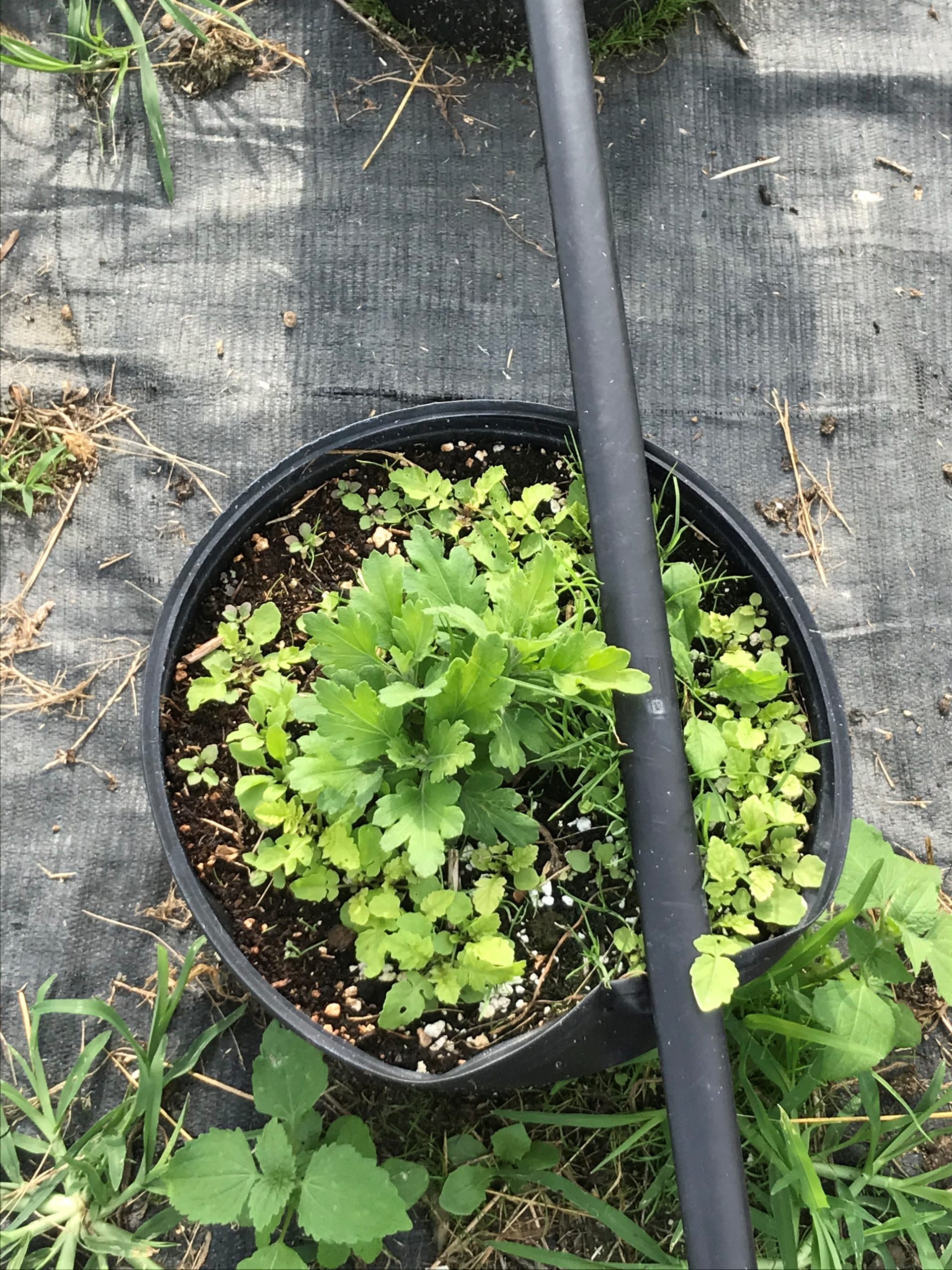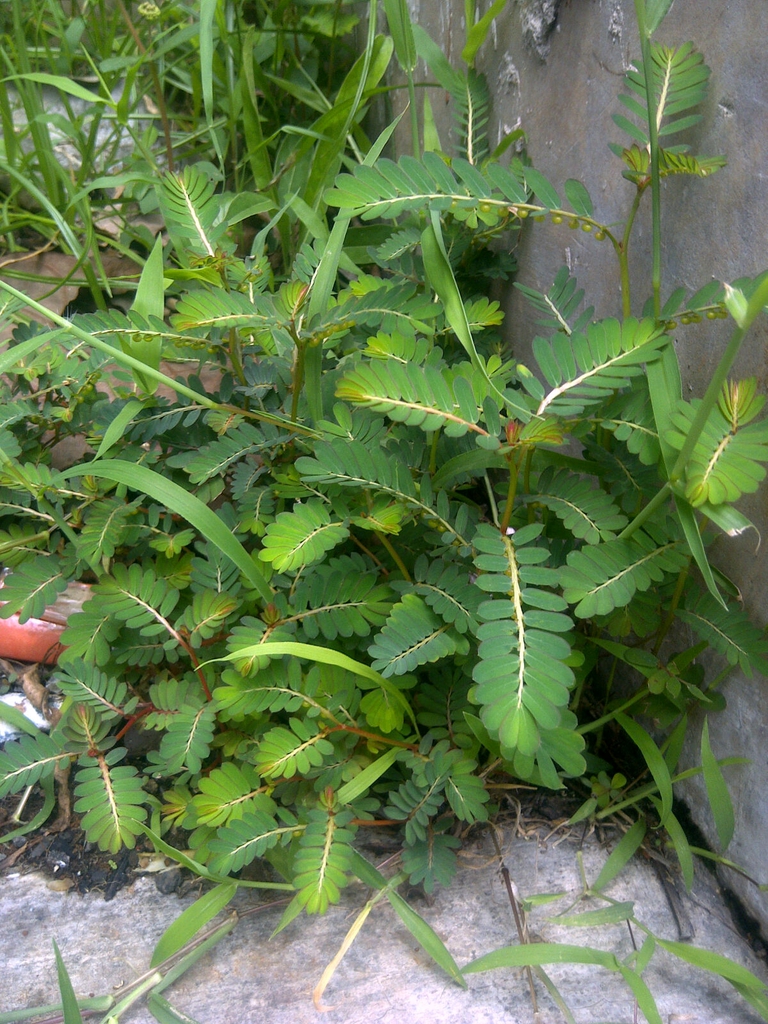The weather caused growers quite a few problems this spring, from severe edema early in the season to a rash of Coleus Downy Mildew just ahead of spring sales. Luckily, the weather finally seems to be increasingly warm and sunny across much of the country. However, we are still seeing the effects of a cooler and wetter spring in the weed populations. Even now that the start of summer is upon us, winter weeds are still sporadically germinating in my area and maybe yours, as well. That means Poa (Annual Bluegrass), Henbit, and Chickweed are still popping out, while Crabgrass, Phyllanthus, Spurge and other summer weeds are also taking off. By taking off, I mean growing like a weed – and setting seed on immature plants. These early weed seeds compound the weed problem over the summer. The best time to break the cycle of weeds is before seeds germinate in the spring. The second-best time is when you notice weeds are present, before they flower and set seed. We want to avoid hand weeding, as it is often the most expensive form of weed control, especially considering the short residual effectiveness, likely just a few days when there is moisture available.
In a situation with actively growing weeds, the best option for control is a combination of a pre-emergent and post-emergent herbicide. Pre-emergent herbicides stop the seeds’ germination or the root establishment process, preventing the weed from getting started. Post-emergent herbicides are used any time after seed germination. However, the smaller the weed, the more effectively the herbicide will kill it, so earlier is better. The two herbicide types are often applied together as a spray tank mix (see below). There are more than a few possible tank mix combinations and most products are generally not effective on all weed types. So, identifying the weeds currently growing, the weeds typically present, and their seasonality can help guide proper product selection.
The correct herbicide choice depends on the location of use, whether inside a greenhouse, outside a greenhouse, production pads, roads, or outdoor container crops. Safety for any crop that is present as well as the surrounding environment are the chief concerns. When treating areas just outside of a greenhouse, it is safest to use a product allowed in the greenhouse. Every season GGSPro receives multiple reports of herbicide damage to greenhouse crops from herbicide drift. A highly preventable, yet somewhat common error is spray tank contamination from using a single sprayer for herbicides as well as plant protection products.
Another potential pitfall occurs when using a pre-emergent herbicide in outdoor container crops. If there will be crop contact, the genus of the crops should be listed as ‘Tolerant’ on the label of any pre-emergent herbicide used. If a crop is not listed on the label, it is critical to test a few plants and allow observation time before the entire crop is treated. It is imperative that the entire label is read when using a pre-emergent herbicide. These products have the longest labels in our industry – because proper use is so critical. Most contain very specific directions for each of the allowed use areas. It is advisable to scan the entire label, at a minimum, and thoroughly reading the general directions and precautions, as well as the directly applicable section(s).
Relatively few pre-emergent products are safe and labeled for legal use on floors in a greenhouse. Only Marengo, Marengo G, and the new SureGuard EZ are labeled for use in enclosed greenhouses. The Marengo products are unique in being allowed on floors while plants are on the benches above. SureGuard EZ has post-emergent activity for small weed seedlings, a nice feature that may eliminate the need for another product in some cases. The new, broader spectrum sister product SureGuard Xtra is not allowed for greenhouse use.
After germination and establishment of a weed, a post-emergent herbicide must be used. Most annual weeds can be killed by a number of post-emergent herbicides. The list of possibilities even includes two OMRI listed products. Organic vegetable or flower growers, or growers just wanting to reduce their synthetic chemical use, can achieve a quick kill of annual weeds using (OMRI-listed) AXXE or FireWorxx. Perennial weeds, however, will only be killed by post emergent herbicides containing glyphosate (e.g., RoundUp and Ranger Pro products) which migrates to the plants’ roots. Some tough weeds like Nutsedge, vines, and rhizomatous plants like Lesser Celandine, are not well controlled by glyphosate and require additional steps or another herbicide. GGSPro can assist with labels and suggestions for individual situations with these tough-to-kill weeds.
Herbicides are formulated both as liquids and granular products in both the pre- and post-emergent categories. There are a couple of advantages of liquid products. The first is that applying a spray is typically more economical than a granular product, due to the costs of the manufacturing processes involved. The second advantage is that pre- and post-emergent herbicide sprays can be applied at the same time in a tank mix to keep production areas clean. The table below lists the spray products that are broadly used in ornamental production areas. Most, but not all, pre-emergent products can be used over some crop containers. Remember to check the tolerance of specific crops against the label and carefully read all restrictions and cautions.

Figure 1: Weeds in the container compete with the Chrysanthemum for water and nutrition.

Figure 2: Phyllanthus, also known as Chamberbitter, and Crabgrass grow in a greenhouse floor.
* Additional sizes are available
Note: Not all products are registered in all states. Some pesticides are restricted use in some states or regions and not others. It is the responsibility of the applicator to read and follow all label directions, remembering that labels may change. Other products may be safe and effective. Rates, application methods, and edible status are detailed in our GGSPro Insecticide & Fungicide Guides. Griffin also offers the 6th Edition GGSPro Technical Reference Guide. This valuable resource outlines a wide range of pest control options and information on pollinator safety, BCA’s, scouting, weed management, plant lighting, nutrition, water quality and more!
In a situation with actively growing weeds, the best option for control is a combination of a pre-emergent and post-emergent herbicide. Pre-emergent herbicides stop the seeds’ germination or the root establishment process, preventing the weed from getting started. Post-emergent herbicides are used any time after seed germination. However, the smaller the weed, the more effectively the herbicide will kill it, so earlier is better. The two herbicide types are often applied together as a spray tank mix (see below). There are more than a few possible tank mix combinations and most products are generally not effective on all weed types. So, identifying the weeds currently growing, the weeds typically present, and their seasonality can help guide proper product selection.
The correct herbicide choice depends on the location of use, whether inside a greenhouse, outside a greenhouse, production pads, roads, or outdoor container crops. Safety for any crop that is present as well as the surrounding environment are the chief concerns. When treating areas just outside of a greenhouse, it is safest to use a product allowed in the greenhouse. Every season GGSPro receives multiple reports of herbicide damage to greenhouse crops from herbicide drift. A highly preventable, yet somewhat common error is spray tank contamination from using a single sprayer for herbicides as well as plant protection products.
Another potential pitfall occurs when using a pre-emergent herbicide in outdoor container crops. If there will be crop contact, the genus of the crops should be listed as ‘Tolerant’ on the label of any pre-emergent herbicide used. If a crop is not listed on the label, it is critical to test a few plants and allow observation time before the entire crop is treated. It is imperative that the entire label is read when using a pre-emergent herbicide. These products have the longest labels in our industry – because proper use is so critical. Most contain very specific directions for each of the allowed use areas. It is advisable to scan the entire label, at a minimum, and thoroughly reading the general directions and precautions, as well as the directly applicable section(s).
Relatively few pre-emergent products are safe and labeled for legal use on floors in a greenhouse. Only Marengo, Marengo G, and the new SureGuard EZ are labeled for use in enclosed greenhouses. The Marengo products are unique in being allowed on floors while plants are on the benches above. SureGuard EZ has post-emergent activity for small weed seedlings, a nice feature that may eliminate the need for another product in some cases. The new, broader spectrum sister product SureGuard Xtra is not allowed for greenhouse use.
After germination and establishment of a weed, a post-emergent herbicide must be used. Most annual weeds can be killed by a number of post-emergent herbicides. The list of possibilities even includes two OMRI listed products. Organic vegetable or flower growers, or growers just wanting to reduce their synthetic chemical use, can achieve a quick kill of annual weeds using (OMRI-listed) AXXE or FireWorxx. Perennial weeds, however, will only be killed by post emergent herbicides containing glyphosate (e.g., RoundUp and Ranger Pro products) which migrates to the plants’ roots. Some tough weeds like Nutsedge, vines, and rhizomatous plants like Lesser Celandine, are not well controlled by glyphosate and require additional steps or another herbicide. GGSPro can assist with labels and suggestions for individual situations with these tough-to-kill weeds.
Herbicides are formulated both as liquids and granular products in both the pre- and post-emergent categories. There are a couple of advantages of liquid products. The first is that applying a spray is typically more economical than a granular product, due to the costs of the manufacturing processes involved. The second advantage is that pre- and post-emergent herbicide sprays can be applied at the same time in a tank mix to keep production areas clean. The table below lists the spray products that are broadly used in ornamental production areas. Most, but not all, pre-emergent products can be used over some crop containers. Remember to check the tolerance of specific crops against the label and carefully read all restrictions and cautions.

Figure 1: Weeds in the container compete with the Chrysanthemum for water and nutrition.

Figure 2: Phyllanthus, also known as Chamberbitter, and Crabgrass grow in a greenhouse floor.
Use |
Use |
& Special Uses |
|||
|---|---|---|---|---|---|
| Barricade 65 WG | 72-1571 | ||||
| Barricade 4FL |
72-1574-(4oz) 72-1575-(1g) 72-15751-(10g) | ||||
| Gallery SC | 72-1645 | ||||
| Gemini 3.7 SC | 72-1682 | ||||
| Marengo |
72-2809-(18oz) 72-28132-(64oz) | ||||
| Pendulum Aquacap | 72-2825 | ||||
| Pennant Magnum | 72-1565 | ||||
| SureGuard EZ |
72-8212-(1pt) 72-8215-(64oz) | ||||
| SureGuard Xtra | 72-8222-(1g) | ||||
| AXXE | 72-1050 | ||||
| Cheetah Pro |
72-1595-(1g) 72-1596-(2.5g) 72-1597-(30g) | ||||
| Envoy Plus | 72-14451 | ||||
| Finale XL T&O | 72-1605 | ||||
| FireWorxx | 72-1608 | ||||
| Fusilade II | 72-1630 | ||||
| Ranger Pro |
72-2885-(2.5g) 72-2890-(30g) | ||||
| Roundup Pro Concentrate | 72-2869 | ||||
| Scythe | 75-10512 | ||||
Note: Not all products are registered in all states. Some pesticides are restricted use in some states or regions and not others. It is the responsibility of the applicator to read and follow all label directions, remembering that labels may change. Other products may be safe and effective. Rates, application methods, and edible status are detailed in our GGSPro Insecticide & Fungicide Guides. Griffin also offers the 6th Edition GGSPro Technical Reference Guide. This valuable resource outlines a wide range of pest control options and information on pollinator safety, BCA’s, scouting, weed management, plant lighting, nutrition, water quality and more!